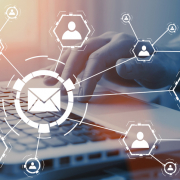Disaster Recovery Planning Step 5 – The Communication Plan
Introduction
So, a catastrophe has occurred, and your Disaster Recovery Plan (DRP) has been initiated. Does your DRP include communicating with employees, key clients, the press, etc.? If not—it should.
A clearly defined Communication Plan helps you “speak with one voice” and get critical information to those that need it. Without a plan—confusion will reign! Here’s how to do it.
Create an internal notification matrix
Very small organizations can get away with the boss calling or emailing individual employees, but for larger companies, this technique is not efficient.
Each department head should have a master list of his or her employees with their contact information. Once you are sure that each manager has this information, create a matrix with the following data as part of your DRP:
- Department / Area
- Designated Contact or Department Manager
- Designated Contact’s Cell
- Designated Contact’s Email
Managers contact direct reports in their department when disaster strikes and pass along relevant information as needed. Managers serve as a point of contact for their direct reports.
The plan should state that employees will be contacted using company-owned cell phones, official company email, etc. first. If these are not operational, then management will communicate using private contact information on file.
Use the company website and social media assets responsibly
It is extremely important that, during an emergency, your company speaks with one voice.
Many organizations have their marketing department post to their website and social media pages. That’s fine; however, during emergencies, all posts should be approved by a central source to avoid sending mixed signals to clients, staff, and the press.
Your plan should list those individuals who will be responsible for posting or approving communications.
Be very careful what is being posted and make sure that whatever is put up on the internet contains information that can and should be shared.
Identify employee only channels
If you don’t already have them, you should set up private communication channels for your employees.
Today, this is very easy to do. You can set up a SharePoint intranet, use Google sites, or perhaps private groups on social media platforms such as Facebook or LinkedIn.
Just make sure that only employees can access them and that they are not exposed to the public.
During emergencies, employees should be directed to these sites for information and two-way communications.
Client communication channels
It is important that during a disaster, your clients are kept informed of your speedy recovery and that everything is going according to plan. They need assurance that you will continue to service their accounts.
If not assured, clients may seek alternative vendors, and competitors may try “poaching” your customer base. This is often a cost to IT downtime not added into company calculations.
Appoint certain individuals as the only ones that are to communicate with client management during a crisis—again, speaking with “one voice.” A matrix is ideal for this purpose.
The matrix should have two columns:
- The designee’s name
- The limits of information they can share
Designees should only comment on their areas of expertise (i.e., Human Resources, Finance, etc.). If a client asks a question they can’t answer, they should be referred to someone who can respond.
Using today’s technology, you can set up client-focused communication channels in case your company’s assets are offline, such as:
- Alternative emergency website (i.e., Google Sites, etc.)
- Public email address (i.e., Gmail)
- Private Facebook or LinkedIn Groups for clients only
Take advantage of today’s technology to infuse resiliency into your Disaster Recovery Plan.
Note: Alternative communication plans need to be set up with clients and employees well before a disaster strikes. Web pages, social media groups, etc. take time to create correctly with proper security. Make sure these assets are restricted to only the intended audience.
Conclusion
Take your time with this module and get the input of your management and staff. Make sure you include input from your IT department. They’ll know what to use and how to secure channels properly.
When disaster strikes, time is your chief enemy. A well thought out, and comprehensive Communication Plan will serve you well and support your recovery efforts.
Related posts:
Now Available: A Simple Disaster Recovery Plan Template
Disaster Recovery Planning Step 1 – The Threat Matrix
Disaster Recovery Planning Step 2 – Critical Processes
Disaster Recovery Planning Step 3 – Declaring A Disaster
Disaster Recovery Planning Step 4 – Evacuation Plan
XSolutions is an Elite Partner of Datto, the world leader in Hybrid-Cloud Business Continuity solutions whose systems protect 460+ Petabytes of data with over 1400+ employees and 9 offices around the globe. Call (845) 362-9675 and let us introduce you to the ultimate defense against data loss—whatever the cause. Backup & Disaster Recovery | Business Continuity | Data Risk Assessment











